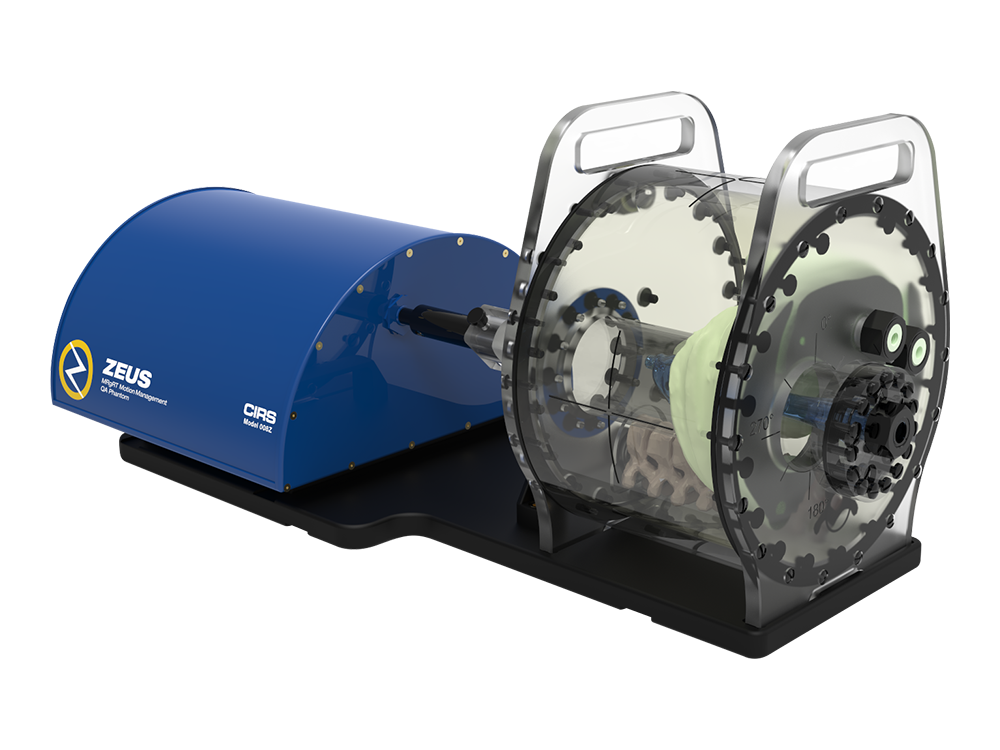
MRGRT MOTION MANAGEMENT QA PHANTOM
IMAGE ACQUISITION - TREATMENT PLANNING - DOSE DELIVERY. The integration of MR imaging in radiation therapy facilitates real time motion management.

Overview
IMAGE ACQUISITION • TREATMENT PLANNING • DOSE DELIVERY
The integration of MR imaging in radiation therapy facilitates real time motion management.
The CIRS Zeus MRgRT Motion Management QA phantom is designed to address such needs. Zeus is safe for use in an MR environment due to the use of piezoelectric motors and nonferromagnetic materials. The two piezoelectric motors move a cylindrical insert, which contain a tracking target, through a gel/ liquid fillable body by rotating it independently from the motion in the Inferior-Superior direction.
The moving insert contains an organic shaped target (tumor) filled with gel, which is surrounded by the same background gel used to fill the body. The body represents a heterogenous background due to simulated lungs, liver, kidney and spine. The simulated organs are anatomical in shape and have a life-like spatial relationship. They are filled with gels that provide contrast in CT and MR versus the background gel, which fills the void between the organs. Besides imaging, all organs, except for the lungs, offer ion chamber dosimetry cavities, which allow for completing an entire QA process; from imaging to planning to verification of dose delivered.
Zeus is designed as a single unit with a piezo actuator fixed permanently to a base plate on which the MRI body “snaps”. This allows for quick setup, removal, filling, and storage purposes. The phantom’s base plate has machined slots on the bottom, which allow for the use of indexing bars for precise and repeatable/reproducible phantom-MRI (MRI-Linac) alignment.
CIRS Motion Control software drives this phantom as well as the other phantoms from the CIRS dynamic family. In addition to multiple built-in motion profiles, which are more appropriate for commissioning and routine QA, the software allows for import of complex patient specific respiratory waveforms. These waveforms can be edited for amplitude, sample rate, cycle time, phase shift and baseline position. It also allows to setup independently controllable waveforms for linear and rotation motion of the insert. The Inferior-Superior motion of the insert/moving target can be gated based on amplitude to allow verification of beam latency. The motion controller box provides an interface (BNC physical input type) for the Beam-on Beam-off signal, which is read by the Motion Control software to calculate the Beam Latency specific to hybrid MRI-Linac systems.
Features:
- Piezoelectric motors, non-ferromagnetic materials => Safe to use in an MR environment
- Easy setup, removal, alignment, positioning
- Organic shaped Organs at Risk and moving target
- Can be imaged in MRI, CT, PET and hybrid systems
- Ion chamber dosimetry in Liver, Kidney, Spine and moving target
- 3D tissue equivalent Spine for bone landmark
- Two independently programmable motions for the moving target
- Import, edit, and save patient specific breathing waveforms in addition to built-in QA waveforms
- Calculate beam latency from beam-on, beam-off signal